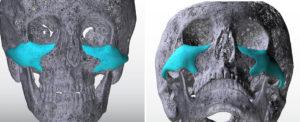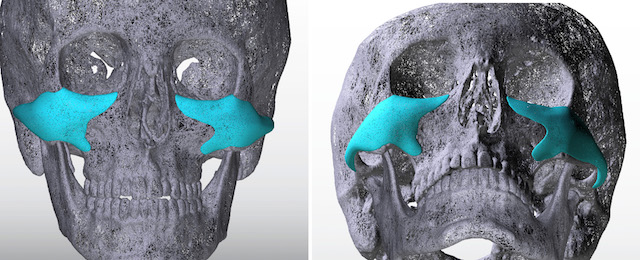Background: Every bone on the face is capable of being underdeveloped and presents different aesthetic issues based on the area affected. The eye area is no different. One of the common periorbital skeletal deficiencies is that of the lower eyelid bone or infraorbital rim. Infraorbital rim recession may occur in isolation ut more commonly extends back to the anterior cheek bones as well given that they are connected and develop together.
When this orbital bone area is recessed the overlying soft tissues are correspondingly pulled back as well. This results in the appearance of lower eyelid bags due to the exposed infraorbital fat pads. (pseudofat herniation) The upper midface will appear flat and a side view will show that the corner of the eyeball is more forward than that of the infraorbital rim. (negative orbital vector) The front part of the cheekbone also has less projection although the more posterior arch component may have adequate with.
The aesthetic correction of infraorbital-malar hypoplasia has been done by various methods. But the ideal approach is to rebuild or augment the deficient bone in a connected and smooth fashion. This is best done using a custom implant approach based on the patient’s 3D CT scan. This allows for a preoperatively controlled shape and dimensions that will optionally fit the bone smoothly. When looking at such implant designs their size can be surprising given their surface area coverage.
Case Study: This young male presented with a desire to improve his undereye appearance. Even though he was young he had a flat sallow appearance to his lower eyes and had fat protrusions….all indicative of a developmental problem not an aging one. He also wanted a stronger cheekbone appearance.



Case Highlights:
1) Infraorbital and anterior malar bone recession typically presents as lower eyelid bags, rim exposure and a negative orbital vector.
2) Skeletal correction ideally requires a bone augmentation approach using a custom implant design.
3) Custom infraorbital-malar implants are placed through a lower eyelid approach for optimal positioning.
Dr. Barry Eppley
Indianapolis, Indiana





